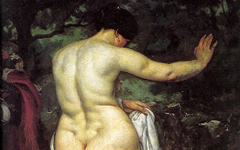Courbet’s The Wheat Sifters (1854-5)
Twenty years ago Michael Fried described Courbet’s The Wheatsifters in terms nearly identical to how we would on this site. The main differences are that he curiously thought that most of Courbet’s clever references to art were subconscious and that they were unique to Courbet. We, on the other hand, argue that many of the methods and meaning in a great artist’s work, at least on the underlying level, are basic bedrock principles and themes of art which all great painters, sculptors, writers and other creators are largely aware of: self-reflection, the act of creation, an esoteric understanding of spirituality etc. Indeed, much of what Fried had to say about this painting, regular users will recognize.1

Courbet, The Wheat Sifters (1854-5) Oil on canvas. Musée des Beaux-Arts, Nantes.
Click image to enlarge.
Fried argues that the main figure sifting grain on canvas subconsciously references how an artist places paint on canvas. In other words, the girl is an “artist” with her canvas, like Jackson Pollock's later, on the floor. The latticed shadow of the sun-lit window suggests to him a painting’s stretcher while the main figure’s extended arm resembles how an artist’s arm stretches towards a painting.
The other woman, dreaming, picks grain off her plate like an artist takes paint from a palette.
Click next thumbnail to continue
Fried thought the two female figures resemble Courbet’s own signed initials, G in the central figure, C to her left, and that the men in Courbet's Stonebreakers are similar. He further suggests that the canvas resembles a blood-stained garment in reference to the woman's menstrual cycle and her fertility. Not only does grain carry similar meaning but artists before Courbet often used the mystery of a woman's body to symbolize the androgyny and fertility of their creative minds.
So, with the reservations mentioned earlier, we agree with Fried wholeheartedly. He deserves more recognition than he gets.
More Works by Courbet
Notes:
1. Fried, Courbet’s Realism (University of Chicago Press) 1990, pp. 151-160
Original Publication Date on EPPH: 20 Nov 2010. | Updated: 0. © Simon Abrahams. Articles on this site are the copyright of Simon Abrahams. To use copyrighted material in print or other media for purposes beyond 'fair use', you must obtain permission from the copyright owner. Websites may link to this page without permission (please do) but may not reproduce the material on their own site without crediting Simon Abrahams and EPPH.




